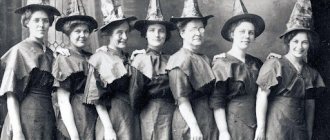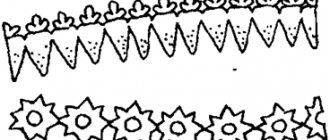Apron
Costume from the author's collection of artists Karelin
Women's urban costume in folk style: jacket, apron. Russia, late 19th century
Women's costume from the Moscow province. Restoration, contemporary photography
The apron not only protected clothes from contamination, but also decorated the festive outfit, giving it a finished and monumental look. The wardrobe apron was worn over a shirt, sundress and poneva. It was decorated with patterns, silk ribbons and finishing inserts, the edge was decorated with lace and frills. There was a tradition of embroidering the apron with certain symbols. From which it was possible, as from a book, to read the history of a woman’s life: the creation of a family, the number and gender of children, deceased relatives.
Shirt
An ankle-length shirt is the main element of Russian costume. Composite or one-piece, made of cotton, linen, silk, muslin or simple canvas. The hem, sleeves and collars of shirts, and sometimes the chest part, were decorated with embroidery, braid, and patterns. Colors and patterns varied depending on the region and province. Voronezh women preferred black embroidery, strict and sophisticated. In the Tula and Kursk regions, shirts, as a rule, are tightly embroidered with red threads. In the northern and central provinces, red, blue and black, sometimes gold, predominated. Russian women often embroidered spell signs or prayer amulets on their shirts.
Different shirts were worn depending on what work had to be done. There were “mowing” and “stubble” shirts, and there was also a “fishing” shirt. It is interesting that the work shirt for the harvest was always richly decorated; it was equated with a festive one.
Fishing shirt. End of the 19th century. Arkhangelsk province, Pinezhsky district, Nikitinskaya volost, Shardonemskoye village.
Mowing shirt. Vologda province. II half of the 19th century
Shirt from the author's collection of the Karelin artists
The word “shirt” comes from the Old Russian word “rub” - border, edge. Therefore, the shirt is a sewn cloth with scars. Previously they used to say not “hem”, but “hem”. However, this expression is still found today.
Sundress
The word “sarafan” comes from the Persian “saran pa” - “over the head”. It was first mentioned in the Nikon Chronicle of 1376. However, the overseas word “sarafan” was rarely heard in Russian villages. More often - a kostych, damask, kumachnik, bruise or kosoklinnik. The sundress was, as a rule, of a trapezoidal silhouette; it was worn over a shirt. At first it was purely men's attire, ceremonial princely vestments with long folding sleeves. It was made from expensive fabrics - silk, velvet, brocade. From nobles, the sundress passed to the clergy and only then became established in the women's wardrobe.
Sundresses were of several types: blind, swing, straight. Swing ones were sewn from two panels, which were connected using beautiful buttons or fasteners. The straight sundress was fastened with straps. A blind oblique sundress with longitudinal wedges and beveled inserts on the sides was also popular.
Costume from the author's collection of artists Karelin.
Sundresses with soul warmers
Recreated holiday sundresses
The most common colors and shades for sundresses are dark blue, green, red, light blue, and dark cherry. Festive and wedding attire was made mainly from brocade or silk, and everyday attire was made from coarse cloth or chintz.
“Beauties of different classes dressed up almost identically - the only difference was the price of the furs, the weight of the gold and the shine of the stones. When going out, a commoner wore a long shirt, over it an embroidered sundress and a jacket trimmed with fur or brocade. The noblewoman - a shirt, an outer dress, a letnik (a garment that flares out at the bottom with precious buttons), and on top there is also a fur coat for added importance.”
Veronica Batkhan. "Russian beauties"
Portrait of Catherine II in Russian dress. Painting by Stefano Torelli
Portrait of Catherine II in shugai and kokoshnik. Painting by Vigilius Eriksen
Portrait of Grand Duchess Alexandra Pavlovna in Russian costume." Unknown artist. 1790 javascript: void(0)
For some time, the sundress was forgotten among the nobility - after the reforms of Peter I, who forbade those close to him to wear traditional clothes and cultivated the European style. Catherine the Great, a famous fashion trendsetter, returned the item of clothing. The Empress tried to instill in her Russian subjects a sense of national dignity and pride, a sense of historical self-sufficiency. When Catherine began to rule, she began to dress in Russian dress, setting an example for the ladies of the court. Once, at a reception with Emperor Joseph II, Ekaterina Alekseevna appeared in a scarlet velvet Russian dress, studded with large pearls, with a star on her chest and a diamond diadem on her head. And here is another documentary evidence from the diary of an Englishman who visited the Russian court: “The Empress was in Russian attire - a light green silk dress with a short train and a bodice of gold brocade, with long sleeves.”
Belt
Women's wool belts
Belts with Slavic patterns
Machine for weaving belts
In Rus', it was customary for a woman’s undershirt to always be belted; there was even a ritual of girding a newborn girl. It was believed that this magic circle protected against evil spirits; the belt was not removed even in the bathhouse. Walking without it was considered a great sin. Hence the meaning of the word “unbelt” - to become insolent, to forget about decency. Wool, linen or cotton belts were crocheted or woven. Sometimes the sash could reach a length of three meters; these were worn by unmarried girls; hem with a voluminous geometric pattern was worn by those who were already married. A yellow-red belt made of woolen fabric with braid and ribbons was worn on holidays.
Cabbage style
A distinctive feature of the Russian national costume is its multi-layered nature. The everyday suit was as simple as possible, it consisted of the most necessary elements. For comparison: a married woman’s festive costume could include about 20 items, while an everyday costume could include only seven. According to legends, multi-layered, loose clothing protected the hostess from the evil eye. Wearing less than three layers of dresses was considered indecent. Among the nobility, complex dresses emphasized wealth.
Peasants sewed clothes mainly from homespun canvas and wool, and from the middle of the 19th century - from factory-made chintz, satin and even silk and brocade. Traditional outfits were popular until the second half of the 19th century, when urban fashion began to gradually supplant them.
We thank the artists Tatyana, Margarita and Tais Karelin - laureates of international and city national costume competitions and teachers - for providing photographs.
Headdress
Costumes from the author's collection of artists Karelin
Costumes from the author's collection of artists Karelin
Costumes from the author's collection of artists Karelin
The headdress depended on age and marital status. He predetermined the entire composition of the costume. Girls' headdresses left part of their hair open and were quite simple: ribbons, headbands, hoops, openwork crowns, and folded scarves.
Married women were required to cover their entire hair with a headdress. After the wedding and the ceremony of “unbraiding the braid,” the girl wore a “young woman’s kitty.” According to ancient Russian custom, a scarf called ubrus was worn over the kichka. After the birth of the first child, they put on a horned kichka or a high spade-shaped headdress, a symbol of fertility and the ability to bear children.
Kokoshnik was the ceremonial headdress of a married woman. Married women wore a kichka and kokoshnik when they left the house, and at home they usually wore a povoinik (cap) and a scarf.
Poneva
Woman suit. Poneva
Woman suit. Poneva
Costume from the author's collection of artists Karelin
Poneva - a baggy skirt - was a mandatory element of a married woman's wardrobe. Poneva consisted of three panels and could be blind or hinged. As a rule, its length depended on the length of the woman's shirt. The hem was decorated with patterns and embroidery. Most often, poneva was sewn from wool blend fabric in a checkered pattern.
The skirt was put on a shirt and wrapped around the hips, and a woolen cord (gashnik) held it at the waist. An apron was usually worn on top. In Rus', for girls who had reached adulthood, there was a ritual of putting on a poneva, which indicated that the girl could already be betrothed.








